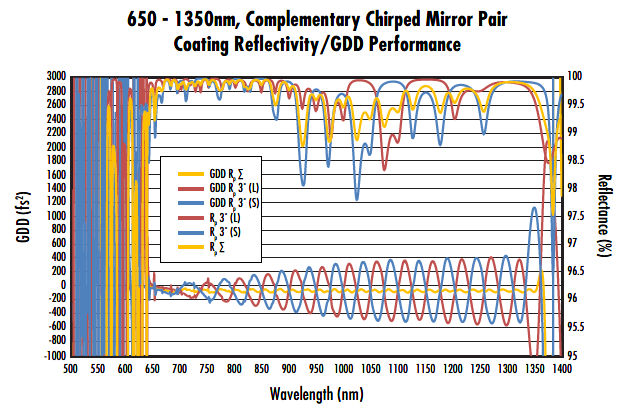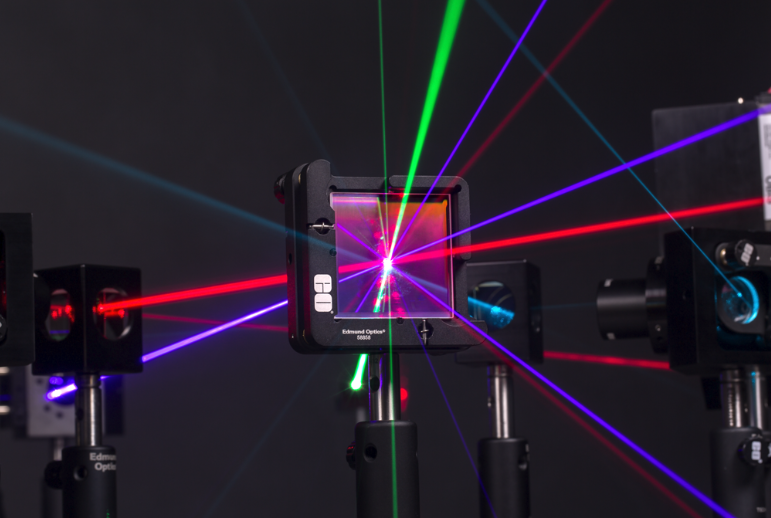Highly-Dispersive Mirrors
This is Sections 13.1, 13.2, and 13.3 of the Laser Optics Resource Guide.
Detailed descriptions of dispersion and how it significantly affects ultrafast laser systems can be found in our Dispersion and Ultrafast Dispersion application notes. The positive chirp, or dispersion, introduced by most optical media in ultrafast systems can be compensated for using optical components, such as highly-dispersive mirrors, that feature negative dispersion. This gives short wavelengths a higher phase velocity than that of long wavelengths, which balances out the positive chirp and compresses the pulse duration (Figure 1).

Figure 1: Highly-dispersive mirrors and other pulse compressing optics introduce negative dispersion, canceling out the positive dispersion experienced by ultrafast laser pulses as they transmit through optical media
Earlier Methods of Dispersion Compensation
Several different types of pulse compressing optics were traditionally used in ultrafast systems before the introduction of highly-dispersive mirrors including prisms, gratings, Gires-Tournois interferometer (GTI) mirrors, and chirped mirrors.
Dispersive Prisms and Gratings
Several prisms and gratings with negative dispersion can be introduced into ultrafast laser systems to balance out positive chirp and compress pulse duration (Figure 2). Dispersive prisms tend to be bulky setups that take up a lot of space. Both dispersive prisms and gratings also typically have low throughput, high sensitivity to alignment and separation distance, and a large amount of third-order dispersion, which increases temporal broadening.

Figure 2: While prisms and gratings can be used for pulse compression, they face a number of disadvantages compared to highly-dispersive mirrors
Gires-Tournois Interferometer Mirrors
It is necessary to understand Gires-Tournois interferometer (GTI) mirrors to understand how highly-dispersive mirrors function. Gires-Tournois interferometers are standing-wave resonators which use a highly-reflective GTI mirror to generate chromatic dispersion. The phase of light reflected by GTI mirrors is wavelength-dependent due to resonance in the mirror’s coating, allowing GTI mirrors to provide angle-dependent negative GDD for ultrafast intracavity dispersion control. However, GTI mirrors introduce some high-order dispersion and they only provide negative GDD over a limited wavelength range.
Chirped Mirrors
It is also important to understand chirped mirrors to fully understand highly-dispersive mirrors. Unlike GTI mirrors, which provide negative GDD using a resonance effect, chirped mirrors introduce a controlled negative GDD by a wavelength-dependent penetration depth into the mirror’s coating. Typical dielectric mirrors are designed to reflect one particular wavelength, while every coating layer in a chirped mirror is designed to reflect a different wavelength. The thickness of coating layers increases from the external mirror surface to the bottom layer, causing long wavelengths to penetrate deeper into the coating and experience longer path lengths than shorter wavelengths, counteracting positive dispersion (Figure 3).

Figure 3: The variable layer thickness of chirped mirrors causes negative dispersion
Unfortunately, the sharp transitions between different layer thicknesses in this simple dielectric structure causes oscillations in group delay dispersion (GDD) as a function of wavelength (Figure 4).

Figure 4: Oscillations in the GDD of an ultrafast chirped mirror due to the discrete switching between different layer thicknesses
Highly-Dispersive Mirrors
Ultrafast highly-dispersive mirrors combine wavelength-dependent penetration, similar to that of chirped mirrors, with a multi-resonance effect in the coating known as multi-GTI.1 This combination counters both the bandwidth limitations of traditional GTI mirrors and the GDD oscillations of chirped mirrors. Highly-dispersive mirrors also provide high throughput, zero third-order dispersion, and negative GDD with a large magnitude, making them ideal pulse compressing optics for ultrafast systems (Figure 5 and Figure 6).

Figure 5: In additional to negative dispersion for ultrafast pulse compression, highly-dispersive mirrors provide high reflectivities to maximize throughput

Figure 6: Ultrafast highly-dispersive mirrors offer negative GDD with a high magnitude and far less wavelength-dependent oscillation than chirped mirrors
The several advantages of ultrafast highly-dispersive mirrors over traditional chirped and GTI mirrors have made them essential elements of ultrafast laser setups. They are highly advantageous for applications in high-energy ultrafast pulse generation that require a negative GDD with a large magnitude. These mirrors allow for pulse compression without increasing the number of bounces off dispersive mirrors, which limits the alignment sensitivity and round-trip losses.
Chirped Mirror Pairs
As shown earlier, highly-dispersive mirrors avoid the third- and higher-order dispersion experienced by traditional compression methods such as gratings and prisms. However, they experience GDD oscillations over bandwidths greater than 100nm, as shown in Figure 4. Chirped mirror pairs may be a better solution for applications where these applications would be detrimental. The mirrors in a chirped mirror pair are chosen to have out-of-phase GDD oscillations, leading to an overall oscillation-free GDD over a large bandwidth (Figure 7). This allows for compression of pulse durations down to <3 fs.

Figure 7: Two chirped mirrors with out-of-phase GDD oscillations are paired to result in a nearly oscillation-free total GDD over a very wide range of wavelengths. "L" and "S" are used to distinguish the mirrors
Highly-Dispersive Mirrors from Edmund Optics®

VIEW NOW
Webinar Recording: Ultrafast Optics: Challenges and Solutions

WATCH NOW
References
- Pervak, V., et al. "High-Dispersive Mirrors for Femtosecond Lasers." Optics Express, vol. 16, no. 14, 2008, pp. 10220–10233., doi:10.1364/oe.16.010220.
More Resources
- Ultrafast Dispersion Application Note
- Highly-Dispersive Ultrafast Mirrors for Dispersion Compensation Video
- Ultrafast Lasers – The Basic Principles of Ultrafast Coherence Application Note
- LIDT for Ultrafast Lasers Application Note
- Trending in Optics: Reflective Laser Beam Shaping
- Trending in Optics: Ultrafast Highly-Dispersive Mirrors
- Laser Optics Lab Video Series













 Previous Section
Previous Section 















or view regional numbers
QUOTE TOOL
enter stock numbers to begin
Copyright 2023, Edmund Optics Inc., 101 East Gloucester Pike, Barrington, NJ 08007-1380 USA
California Consumer Privacy Acts (CCPA): Do Not Sell or Share My Personal Information
California Transparency in Supply Chains Act